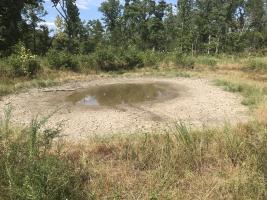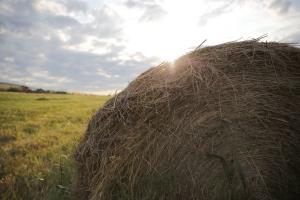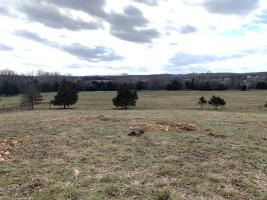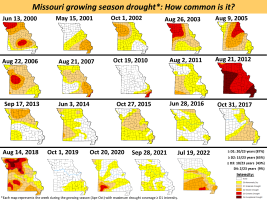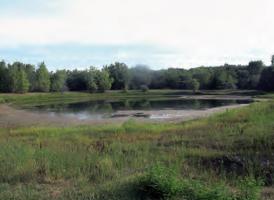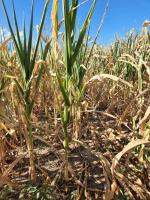Things to consider as you feed your way through the drought
“Cattle producers are dealing with varying degrees of drought and forage resources,” says Patrick Davis MU Extension livestock field specialist. Some cattle producers have received adequate rain and are recovering from the 2022 drought through rebuilding forage and cattle resources. Other cattle producers have received limited rain and are continuing to deal with drought conditions from 2022 with less resources in 2023.
Top 5 livestock forage actions to take during drought
COLUMBIA, Mo. – Most of Missouri is experiencing drought conditions, which have extended almost a full year, putting enormous pressure on cattle producers. University of Missouri Extension specialists have five top action items for producers to do now:
Ammoniation stretches hay supplies during drought
This is part of an MU Extension series to help row crop and livestock producers manage drought. For more articles, go to https://mizzou.us/DroughtResources.COLUMBIA, Mo. – As hay supplies dwindle, University of Missouri Extension agronomist Rusty Lee is showing forage producers how to use a simple, inexpensive treatment to stretch feed supplies during drought.
Trees in drought: Love and water deeply
VERSAILLES, Mo. – With more than 90% of Missouri under drought, browning lawns and wilting cornfields are common sights. But don’t forget about your trees. A lawn can be replaced in months, but it takes decades to replace a large tree, says University of Missouri Extension natural resources specialist Joni Harper.Trees are a valuable part of home landscapes, says Harper. They beautify surroundings and help save energy by providing…
Use spray-wait-spray to renovate drought-stricken pastures
This is part of an MU Extension series to help row crop and livestock producers manage drought. For more articles, go to https://mizzou.us/DroughtResources. COLUMBIA, Mo. – Forage producers can convert tall fescue pastures to nontoxic novel-endophyte fescue without incurring the main expense usually associated with pasture renovation through mid-July.
What is the cost of baling wheat straw?
This is part of an MU Extension series to help row crop and livestock producers with drought.COLUMBIA, Mo. – With Missouri forage supplies in short supply due to drought, some livestock producers are looking at wheat straw as feedstuff, despite its poor nutrient quality.
High heat and dry conditions can put fish ponds at risk
COLUMBIA, Mo. – The combination of prolonged high heat and dry weather potentially threatens fish ponds, says a University of Missouri Extension fisheries and wildlife specialist.“Fish are at risk from high water temperatures, oxygen depletion, increased disease potential and other problems as water levels drop in ponds through lack of runoff and evaporation,” said Bob Pierce.
Bristle for thistles that run amok
GALENA, Mo. – Thistles have taken advantage of grass stands weakened by drought, and many southwestern Missouri fields now have large amounts of musk and bull thistles, says University of Missouri Extension agronomist Tim Schnakenberg.He reminds Missouri landowners that state law requires them to control all Canada, musk or Scotch thistles and prevent them from going to seed.
Water deeply and wisely during drought
HILLSBORO, Mo. – During drought, proper watering can help plants survive dry spells, says University of Missouri Extension horticulturist Debi Kelly.Kelly gives 10 tips to help your plants survive lack of precipitation.1. Water in the morning. Watering in the evening lets water remain on leaves, making the plant susceptible to disease.2. Water at the base of the plant. Water at soil level to avoid waste and prevent foliar diseases.
MU Extension specialists report thin pasture stands, low yields
COLUMBIA, Mo. – University of Missouri Extension agronomists are reporting thin pasture stands and low yields statewide in the wake of re-emerging dry conditions.“Most barns are empty. Most fence rows are empty,” says Terry Halleran, an agronomist in Hickory County in southwestern Missouri. “Farmers are getting nervous.”
Cheap hay isn't cheap
SPRINGFIELD, Mo. – Squatty, squishy bales are making their way out of the ditch and into the cow pasture as post-drought supplies dwindle and winter lingers.Bad bales are costly in many ways, says Derrell Peel, Oklahoma State University Extension agribusiness livestock specialist. Peel spoke at the 39th annual Southwest Missouri Forage Conference sponsored by University of Missouri Extension and others.
Get back to the basics on post-drought pastures
CLEVER, Mo. – Recurring drought calls for forage producers to get back to the basics of farming, says University of Missouri Extension agronomist Terry Halleran.“Practice standard farming practices to rebuild pastures following drought,” he says. Halleran spoke March 7 at the Christian County Livestock and Forage Conference in Clever, Missouri. Southwestern Missouri livestock producers have been especially hard hit from drought in…
Regional drought calls for winter feed strategies
MOUNT VERNON, Mo. – Drought in southwestern Missouri calls for long- and short-term feed plans for beef and dairy herds.University of Missouri Extension state dairy specialist Stacey Hamilton urges producers not to panic as local feed supplies dwindle. There are options to carry herds through winter until spring pastures green.
Plan to meet weaning challenges
SEDALIA, Mo. – Weaning spring calves may be more of a challenge this year because of short pasture supplies and the questionable nutritional value of this year’s hay crop.“Pay very close attention to body condition score in September and be prepared to wean, if necessary,” said Gene Schmitz, University of Missouri Extension livestock specialist in Sedalia.Schmitz recently worked through a feeding scenario for a producer that highlights…
Drought recovery forage options
GALENA, Mo. – “If there was ever a year to focus on stockpiled tall fescue, this is it,” says Tim Schnakenberg, University of Missouri Extension agronomy specialist in Galena.
Apply fall nitrogen now to boost forage stockpiles
COLUMBIA, Mo. – University of Missouri Extension nutrient management specialist John Lory recommends applying fall nitrogen in mid-August to cool-season pastures.Despite drought conditions in much of the state, Lory says, “we need to get nitrogen applied now so we can take full advantage of the rains when they do arrive.”
Drought requires feed efficiency in cattle
WEST PLAINS, Mo. – Low supplies of hay make feeding cattle a challenge.Elizabeth Picking, a University of Missouri Extension livestock specialist in southwestern Missouri, sees the effects of severe drought in her area – dwindling hay supplies, poor-quality hay, high prices and ponds going dry.
SW Missouri no stranger to drought in forages
WEST PLAINS, Mo. – Southwest Missouri farmers and livestock producers are no strangers to drought. In 2022, livestock owners face short-term and long-term challenges growing pastures for grazing and winter feeding.
How to help your trees recover from drought
COLUMBIA, Mo. – Dry soil conditions can significantly reduce the life span of valuable landscape trees.“Because they are difficult and expensive to replace, your trees need attention during and after periods of drought,” says University of Missouri Extension state forestry specialist Hank Stelzer.
Short forage supplies require producers to make tough decisions
COLUMBIA, Mo. – Dry weather and short pastures have reduced forage supplies, prompting livestock producers to ponder “could have, would have, should have” scenarios, says University of Missouri Extension livestock specialist Eric Meusch.Producers should try to match their herd needs to anticipated forage supplies, Meusch says. This requires planning before a drought. Many factors will be out of your control if you wait until drought…
How to manage drought-stressed ponds
This is part of an MU Extension series to help with drought management.COLUMBIA, Mo. – Drought combined with high temperatures can have devastating effects on fish ponds, but pond owners can take steps to alleviate these effects.
Nitrate, prussic acid poisoning follow drought
COLUMBIA, Mo. – Nitrates and prussic acid build up in forages to levels dangerous to livestock during drought.Livestock face severe illness and even death after eating affected forages, says University of Missouri Extension agronomist Jamie Gundel.Nitrates tend to concentrate in the bottom third of the plant. It shows in the plant’s stem and stalks more than leaves, Gundel says.
Tough culling decisions come with drought, forage shortages
COLUMBIA, Mo. – With dry weather and short pastures, Missouri cow-herd owners face tough culling decisions. One way to match cows’ needs to available grass is to sell cows.Give careful thought to which grass eaters go first, says Eric Bailey, University of Missouri Extension beef nutritionist. Under drought stress, identifying those cows becomes urgent.
Corn silage as a forage
COLUMBIA, Mo. – An emergency feeding situation is shaping up for Missouri’s beef producers because of the drought. University of Missouri Extension recently hosted University of Wisconsin agronomist Joe Lauer on the MU Extension Forage and Livestock Hour to discuss his research on corn silage as a forage.
Missouri dairy producers have their eyes on the drought
COLUMBIA, Mo. – Northern Missouri has received plenty of rain, and dairy producers there are hopeful about making a silage pile, while those in the state’s southern counties are looking at options as drought conditions and oppressive heat have taken hold.

